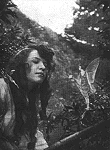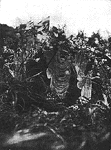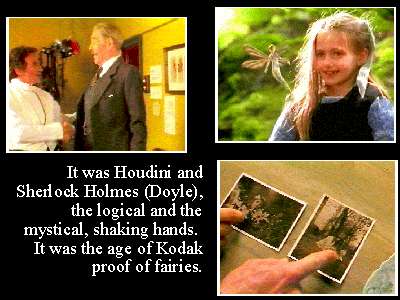
| 
| Nine-year-old Frances Griffiths was in trouble.She had been playing down near the stream called Cottingley beck and had slipped on wet stepping stones, falling into the water soaking her shoes and stockings. Her mother would not be pleased. Especially since her mother had told Frances to stay away from the stream.
In that year, 1917,Frances Griffiths had just arrived in England from South Africa and she and her mother were staying with Frances's aunt. Frances and her cousin, sixteen-year-old Elsie Wright, often played together near the beck to the annoyance of their mothers. When Frances returned from the stream that day with wet feet, her mother persisted in asking her why she constantly returned to that forbidden place. The girl's answer precipitated a strang affair that lasted nearly 70 years and involved one of the greatest literary minds of the day.
She told her mother she went to see the fairies. Her mother and aunt greeted this statement with disbelief. Frances's cousin Elsie added that she had seen the fairies too, and suggested to Frances that they borrow Mr. Wright's camera and take some photographs of them. Within a half hour of taking the camera, they were back begging Elsie's father to develop the film plates for them. After tea, Mr. Wright (with Elsie at this side) developed the film in his darkroom. He was astonished when the picture showed Frances looking straight at the camera while a group of five fairies danced before her on an earthen bank. After the initial surprise, Mr. Wright dismissed the fairies as cardboard cutouts. He knew his daughter was a talented artist who enjoyed drawing fairy figures. Eventually Mr. Wright stopped loaning his camera to his daughter and niece after they took another photo with Elsie posed next to what appeared to be a gnome.
Except for a few copies of the pictures given to friends and family the whole matter might have stayed a private affair. In 1919 the mothers Polly Wright and Annie Griffiths attended a meeting about Theosophy. Theosophy was philosophy that included in its teaching the possibility of nature spirits. After the meeting was over the women approached the speaker about the pictures. This brought the photographs to the attention of Edward Gardner, a well-known leader in the Theosophical movement. He wrote to Polly Wright telling her that the photographs were "the best of its kind I should think anywhere." Gardner obtained from the Wrights the original negative glass plates and sent them to photographic expert Harold Snelling. It was said of Snelling, "What Snelling doesn't know about faked photography isn't worth knowing."
After examing them Snelling concluded, "This plate is a single exposure. These dancing figures are not made of paper nor any fabric; they are not painted on a photographic background-but what gets me most is that all these figures have moved during the exposure." What Snelling meant by his last sentence was that the camera's shutter speed must have been set very low (something that can be confirmed by the movement of the blurred waterfall behind Frances in the first picture) and that the fairies appeared to be blurred as if the exposure had caught them moving in their dance.
Gardner showed the pictures to his cousin, who in turn brought them to the attention of Sir Arthur Conan Doyle. Conan Doyle was author of the Sherlock Holmes stories as well as several novels including The Lost World.
Conan Doyle was a member of the Spiritualist movement and believed that the living could communicate with the dead through psychics and seances. He was very open to the idea of fairies and welcomed the photos as evidence of a world beyond physical reality. Conan Doyle considered going to Bradford himself to interview the family, but was too busy preparing for a trip to Australia. He asked Gardner to go instead.
After talking to the girls, Gardner reported to Conan Doyle that he believed they were telling the truth. Conan Doyle then used the pictures in a story he was writing about fairies for The Strand magazine and suggested that more photographs be taken while the girls were being observed by a "disinterested witness."
| 
| 
| 
| 
| 
| The Pictures 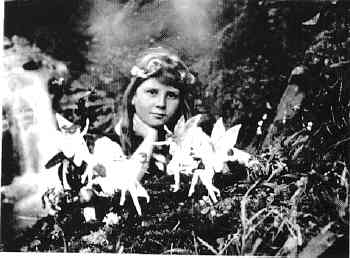
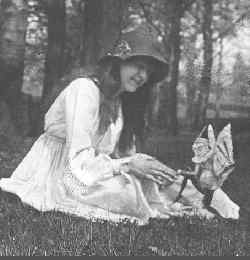
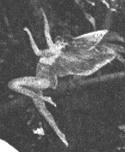
| 
| 
| 
| 
| 
| The article received much criticism. Major Edward Halls, a radium expert, wrote: "On the evidence I have no hesitation in saying that these photographs could have been faked. I criticize the attitude of those who declare there is something supernatural in the circumstances attending to the taking of these pictures because, as a medical man, I believe that the inculcation of such absurd ideas into the minds of children will result in later life in manifestations and nervous disorder and mental disturbances..."
In 1920 Edward Gardner returned to Bradford with a new cameras and persuaded the girls to try to get some more fairy pictures. In a few weeks they had taken several additional photographs with fairies in them. This made a total of five.
In 1921 a well-known clairvoyant, Geoffrey Hodson ,was brought to Cottingley to see if he could detect the spirits. He claimed that he, like the girls, could swhether the girls had actually captured fairies on film.
Meanwhile the world lost track of Elsie and Frances. In 1966 Peter Chambers of the Daily Express decided to do a follow-up on the stories and located Elsie. She told him in an interview that the fairies might have been "figments of my imagination," but it was unclear if she meant that she had indeed faked the photographs or somehow believed she had photographed her thoughts.
Five years later the BBC-TV program Nationwide approached Elsie for another interview. Elsie seemed very evasive on whether she had actually photographed real fairies and the BBC crew came to the conclusion that the pictures had been paper cutouts made to stand up with hat pins.
Finally in 1981 and 1982 Joe Cooper interviewed Frances and Elsie for an article in The Unexplained. Elsie admitted that all five of the photographs had been faked. Frances claimed
that the first four had been faked, but the fifth was real. Both ladies contended they had indeed seen real fairies near the beck. The hoax had been carried out by using the cutout and hatpin method as many people had suspected. Elsie had some art training and drew the characters based on drawings by Arthur Shepperson in Princess Mary's Gift Book of which Frances owned a copy. Using a sharp pairof scissors owned by Frances's mother, they cut them out and secured them to a bank of earth with hat pins. After the photographs were taken, they dropped the evidence into the stream and
brought the camera back to Elsie's father so that he could develop the pictures. Though some had suspected Mr. Wright of being in on the hoax, the girls deny he knew anything about it.
Looking at the photographs now, it seems amazing anyone could not see that the figures are one-dimensional cardboard or paper cutouts. In a careful examination of the gnome picture, it is possible to see where the pin passes through the paper. Elsie herself in 1982 expressed surprise that so many people were fooled by what seemed to her an obvious fake.
Still, we must remember that photography was a new art then and people were not as experienced in seeing
photographs as we are today. Also the images were cleaned up and sharpened for their publication in The Strand. Finally, perhaps we can excuse some of Conan Doyle's gullibility in accepting the images remembering that he had a photographic expert (Snelling) examine the pictures and state they were not fakes. What excuse Snelling might have had is hard to imagine..
The story of the Cottingley Fairies was put to film in 1997 under the title Photographing Fairies.
Perhaps the whole affair can best be summed up by a quote from a columnist in the newspaper Truth on the Conan Doyle's Strand article.
"For the true explanation of these fairy photographs what is wanted is not a knowledge of occult phenomena, but a knowledge of children." | 
| 
|


